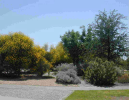Xeriscape
 Water Conservation is an important habit that we all need to consider in our day-to-day life. In order to coexist in a desert locale we must find alternative ways to stretch our watersource. Most of us enjoy having a green lawn and a bountiful garden, but this really isn’t practical in our arid environment. Therefore we’d like to introduce you to the concept of Xeriscaping. This is a type of landscaping that acknowledges water conservation and ecological processes as key players, while providing the homeowner with a beautiful alternative to high water use landscape.
Water Conservation is an important habit that we all need to consider in our day-to-day life. In order to coexist in a desert locale we must find alternative ways to stretch our watersource. Most of us enjoy having a green lawn and a bountiful garden, but this really isn’t practical in our arid environment. Therefore we’d like to introduce you to the concept of Xeriscaping. This is a type of landscaping that acknowledges water conservation and ecological processes as key players, while providing the homeowner with a beautiful alternative to high water use landscape.
Demonstration Garden at El Paso Center
 At the El Paso Research and Extension Center we have provided a creative landscape designed to be used as a model for xeriscaping, native to our very own Chihuahua desert, but we’ve also provided a variety of plants from different regions. All of these plants require small quantities of water for growth. There are many colorful flowers, shrubs and trees that thrive in a desert home. They demonstrate that with a correct landscape plan, regional gardens can be watertight and beautiful. By contrast, a traditional landscape requires irrigation that can account for 40-60% of your summer water use. A Watertight landscape plan is not only beautiful but will typically use less fertilizer, and pesticide.
At the El Paso Research and Extension Center we have provided a creative landscape designed to be used as a model for xeriscaping, native to our very own Chihuahua desert, but we’ve also provided a variety of plants from different regions. All of these plants require small quantities of water for growth. There are many colorful flowers, shrubs and trees that thrive in a desert home. They demonstrate that with a correct landscape plan, regional gardens can be watertight and beautiful. By contrast, a traditional landscape requires irrigation that can account for 40-60% of your summer water use. A Watertight landscape plan is not only beautiful but will typically use less fertilizer, and pesticide.
Award Winning Cactus Garden at El Paso Center
The High Desert Cactus Garden at the Texas AgriLife Research Center at El Paso, was created by the El Paso Master Gardeners and El Paso AgriLife Extension to demonstrate landscape techniques that are low water use, low maintenance and low cost. The garden provides education on methods to create aesthetically pleasing landscapes utilizing cacti and accent plants native to the eco-system of our desert. This garden, open to the public at no cost, is handicapped accessible. A primary focus is the ethical acquisition of native plants. Most plants in the garden were obtained from “cactus rescues”, plants that would have been lost because of real-estate development. The Cactus Garden and borchures have been recognized with 3 statewide Awards for excellence.
Development of the Cactus Garden
Download Cactus Garden Brochures:
Landscape Plant and Irrigation Research Reports & Guidlines
- Impact of Nanoparticles on Food Crop Growth and Potential Health Hazard
- Evaluation of Salt Tolerance of Chile Peppers
- Salt Tolerance of Herbaceous Perennials and Groundcovers
- Evaluation of Salt Tolerance of Garden Roses
- Evaluation of Salt Tolerance of Bedding Plants
- Drought Tolerance and Minimum Water Use of Landscape Plants
- Determining Water Use and Crop Coefficient of Landscape Plants
- Beneficial Effects of Cellulosic Bioenergy Crops on Soil Salinity
- Evaluation of Salt and Water Stress Tolerance of Oil Seed Crops
- Sustainable Practices in Ornamental Crop Production Systems
- El Paso Guidelines for Landscape Uses of Reclaimed Water With Elevated Salinity (Large download, 5 MB)
- Photo Guide – Landscape Plant Response to Salinity (Large download, 3.7 MB)
- Landscape Irrigation With Water of Elevated Salinity
- Landscape Plant Lists for Salt Tolerance Assessment (Large download, 3.7 MB)
- Foliar Salt Damage of Landscape Plants (Large download, 16 MB)
- Soil Resources of El Paso (Large download, 13MB)
- Salt Tolerance of Landscape Plants Common to the Southwest
- A Dash of Salt: Researcher Assesses Salinity Impacts on Grasses, Trees and Shrubs
- Guidelines for Landscape Uses of Reclaimed or Saline Water
- Identification of Salt Sources Entering the Pecos River
- Managing Pecan Orchards Under Water Quality Constraint
- Salinity Impacts on Pecan Trees
- Salinity Simulation of the Rio Grande Above Amistad
- Determining Water Use and Crop Coefficient of Landscape Plants
- Drought Tolerance and Minimum Water Use of Landscape Plants
- Salt Tolerance of Herbaceous Perennials and Groundcovers
- Ornamental Plants for Far West Texas
- Chihuahuan Desert Gardens
- Desert Blooms – Plant Guide for El Paso
- Cloning Live Oak